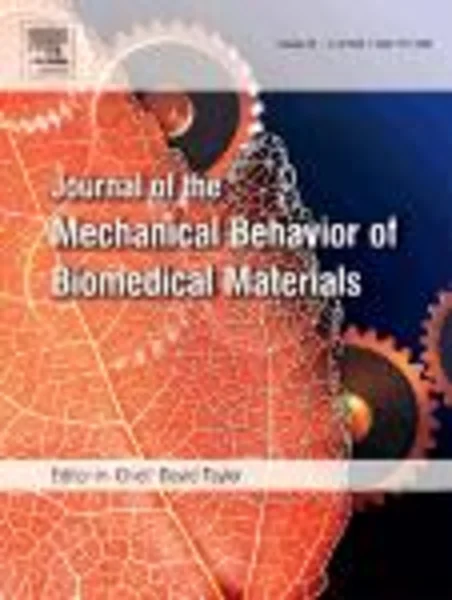-
fatigue behavior of tini foams processed by the magnesium space holder technique
جزئیات بیشتر مقاله- تاریخ ارائه: 1394/01/01
- تاریخ انتشار در تی پی بین: 1394/01/01
- تعداد بازدید: 783
- تعداد پرسش و پاسخ ها: 0
- شماره تماس دبیرخانه رویداد: -
while the wide range of applications of tini alloys makes them highly appealing due to their shape memory and superelasticity properties, the production of tini in the porous form further enlarges their application fields. porous tini alloys have been studied extensively for biomedical applications since their elastic modulus is similar to that of bone. accordingly, tini foams have been widely characterized in terms of their various mechanical properties; however, their fatigue properties have not been well studied, even though this is of vital importance in structural applications such as medical implants. in the scope of this study, tini foams processed from prealloyed powders by the magnesium space holder technique were mechanically characterized by monotonic and cyclic compression tests. tini foams with a porosity range of 49–64 vol.%, which is suitable for bone ingrowth, were determined to have a compressive strength varying in the range 93.27–273.45 mpa. moreover, the wide range of elastic modulus values obtained (2.93–8.71 gpa) is promising for fulfilling various requirements of different implant applications without causing stress shielding. on the other hand, the endurance limit of tini foams was determined to be 0.6σy, where σy is the yield strength, independent of the porosity content. fractography studies on the failed foams after fatigue testing revealed that the failure occurs by the coalescence of micro-cracks initiated from pore walls leading to macro-crack formation aligned at 45 ° with respect to the loading axis.
مقالات جدیدترین رویدادها
-
استفاده از تحلیل اهمیت-عملکرد در ارائه الگوی مدیریت خلاقیت سازمانی و ارائه راهکار جهت بهبود
-
بررسی تاثیر ارزش وجوه نقد مازاد بر ساختار سرمایه شرکت های پذیرفته شده در بورس اوراق بهادار تهران
-
بررسی تأثیر سطح افشای ریسک بر قرارداد بدهی شرکت های پذیرفته شده در بورس اوراق بهادار تهران
-
بررسی تأثیر رتبه بندی اعتباری مبتنی بر مدل امتیاز بازار نوظهور بر نقد شوندگی سهام با تأکید بر خصوصی سازی شرکت ها
-
تأثیر آمیخته بازاریابی پوشاک ایرانی بر تصویر ذهنی مشتری پوشاک ایرانی (هاکوپیان)
-
تأثیر مدل کسب شایستگی مدیریتی مبتنی بر انتظارات در پرستاری، بر توانمندی کارکنان پرستاری و اثربخشی سبک رهبری مدیران پرستاری
-
شبیه سازی زنجیره تأمین با استفاده از نرم افزار ارنا
-
تحلیلی بر لزوم برنامه آمایش جنگل در برنامه ریزی منابع جنگلی زاگرس
-
محاسبه و بررسی تلفات ترانسفورماتور توزیع شهرستان همدان در شرایط محیطی مختلف
-
خواص ساختاری و اپتیکی لایه های نازک v2o5 در غلظت های متفاوت
مقالات جدیدترین ژورنال ها
-
مدیریت و بررسی افسردگی دانش آموزان دختر مقطع متوسطه دوم در دروان کرونا در شهرستان دزفول
-
مدیریت و بررسی خرد سیاسی در اندیشه ی فردوسی در ادب ایران
-
واکاوی و مدیریت توصیفی قلمدان(جاکلیدی)ضریح در موزه آستان قدس رضوی
-
بررسی تاثیر خلاقیت، دانش و انگیزه کارکنان بر پیشنهادات نوآورانه کارکنان ( مورد مطالعه: هتل های 3 و 4 ستاره استان کرمان)
-
بررسی تاثیر کیفیت سیستم های اطلاعاتی بر تصمیم گیری موفق در شرکتهای تولیدی استان اصفهان (مورد مطالعه: مدیران شرکتهای تولیدی استان اصفهان)
-
بررسی چگونگی تاثیر هندسه فضای ورودی در حفظ و ایجاد محرمیت و درونگرایی در خانه های قاجاری تبریز
-
بررسی روند رسیدگی به قضیه ماکس پلانت در دیوان بین مللی حقوق دریاها
-
بررسی رابطه بین عوامل رفتاری شرکت با رضایتمندی مشتریان بیمه معلم
-
تدوین مدل معادلات ساختاری اهمال کاری بر اساس سرمایه روان شناختی (امید، خوش بینی، تاب آوری و خودکارآمدی) با اثر تعدیل کنندگی تفکر انتقادی
-
بررسی عوامل مرتبط با رضایت معلمان از نظام ارزشیابی کیفی - توصیفی در مدارس ابتدایی ناحیه دو شهر زنجان




سوال خود را در مورد این مقاله مطرح نمایید :